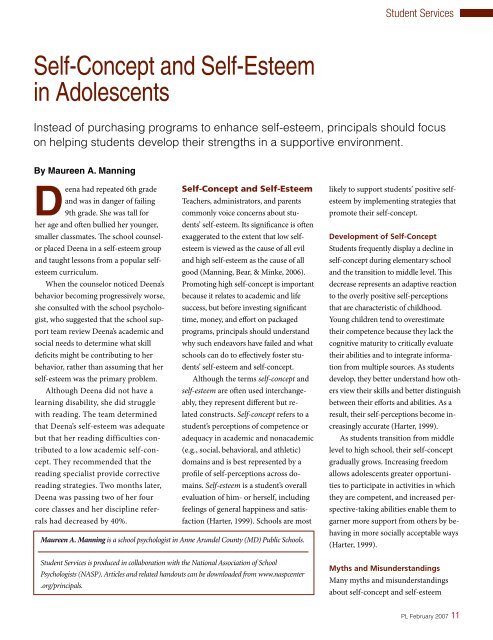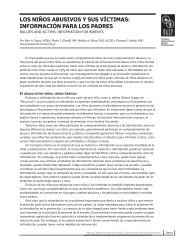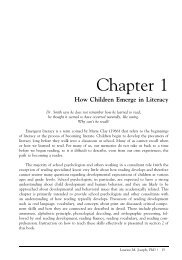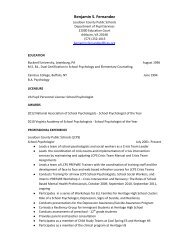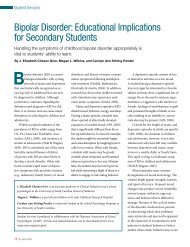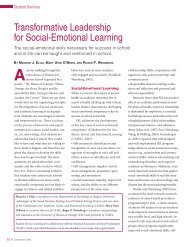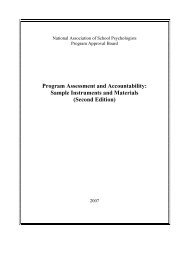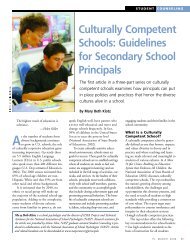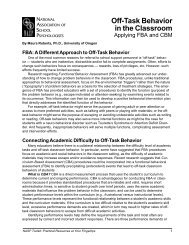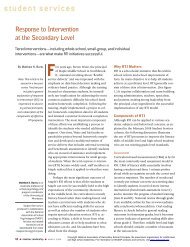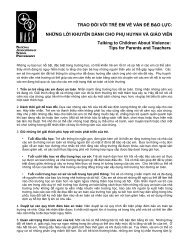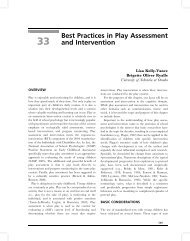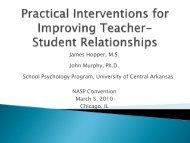Self-Concept and Self-Esteem in Adolescents - National Association ...
Self-Concept and Self-Esteem in Adolescents - National Association ...
Self-Concept and Self-Esteem in Adolescents - National Association ...
You also want an ePaper? Increase the reach of your titles
YUMPU automatically turns print PDFs into web optimized ePapers that Google loves.
<strong>Self</strong>-<strong>Concept</strong> <strong>and</strong> <strong>Self</strong>-<strong>Esteem</strong><br />
<strong>in</strong> <strong>Adolescents</strong><br />
By Maureen A. Mann<strong>in</strong>g<br />
Deena had repeated 6th grade<br />
<strong>and</strong> was <strong>in</strong> danger of fail<strong>in</strong>g<br />
9th grade. She was tall for<br />
her age <strong>and</strong> often bullied her younger,<br />
smaller classmates. The school counselor<br />
placed Deena <strong>in</strong> a self-esteem group<br />
<strong>and</strong> taught lessons from a popular selfesteem<br />
curriculum.<br />
When the counselor noticed Deena’s<br />
behavior becom<strong>in</strong>g progressively worse,<br />
she consulted with the school psychologist,<br />
who suggested that the school support<br />
team review Deena’s academic <strong>and</strong><br />
social needs to determ<strong>in</strong>e what skill<br />
deficits might be contribut<strong>in</strong>g to her<br />
behavior, rather than assum<strong>in</strong>g that her<br />
self-esteem was the primary problem.<br />
Although Deena did not have a<br />
learn<strong>in</strong>g disability, she did struggle<br />
with read<strong>in</strong>g. The team determ<strong>in</strong>ed<br />
that Deena’s self-esteem was adequate<br />
but that her read<strong>in</strong>g difficulties contributed<br />
to a low academic self-concept.<br />
They recommended that the<br />
read<strong>in</strong>g specialist provide corrective<br />
read<strong>in</strong>g strategies. Two months later,<br />
Deena was pass<strong>in</strong>g two of her four<br />
core classes <strong>and</strong> her discipl<strong>in</strong>e referrals<br />
had decreased by 40%.<br />
Maureen A. Mann<strong>in</strong>g is a school psychologist <strong>in</strong> Anne Arundel County (MD) Public Schools.<br />
Student Services is produced <strong>in</strong> collaboration with the <strong>National</strong> <strong>Association</strong> of School<br />
Psychologists (NASP). Articles <strong>and</strong> related h<strong>and</strong>outs can be downloaded from www.naspcenter<br />
.org/pr<strong>in</strong>cipals.<br />
Student Services<br />
Instead of purchas<strong>in</strong>g programs to enhance self-esteem, pr<strong>in</strong>cipals should focus<br />
on help<strong>in</strong>g students develop their strengths <strong>in</strong> a supportive environment.<br />
<strong>Self</strong>-<strong>Concept</strong> <strong>and</strong> <strong>Self</strong>-<strong>Esteem</strong><br />
Teachers, adm<strong>in</strong>istrators, <strong>and</strong> parents<br />
commonly voice concerns about students’<br />
self-esteem. Its significance is often<br />
exaggerated to the extent that low selfesteem<br />
is viewed as the cause of all evil<br />
<strong>and</strong> high self-esteem as the cause of all<br />
good (Mann<strong>in</strong>g, Bear, & M<strong>in</strong>ke, 2006).<br />
Promot<strong>in</strong>g high self-concept is important<br />
because it relates to academic <strong>and</strong> life<br />
success, but before <strong>in</strong>vest<strong>in</strong>g significant<br />
time, money, <strong>and</strong> effort on packaged<br />
programs, pr<strong>in</strong>cipals should underst<strong>and</strong><br />
why such endeavors have failed <strong>and</strong> what<br />
schools can do to effectively foster students’<br />
self-esteem <strong>and</strong> self-concept.<br />
Although the terms self-concept <strong>and</strong><br />
self-esteem are often used <strong>in</strong>terchangeably,<br />
they represent different but related<br />
constructs. <strong>Self</strong>-concept refers to a<br />
student’s perceptions of competence or<br />
adequacy <strong>in</strong> academic <strong>and</strong> nonacademic<br />
(e.g., social, behavioral, <strong>and</strong> athletic)<br />
doma<strong>in</strong>s <strong>and</strong> is best represented by a<br />
profile of self-perceptions across doma<strong>in</strong>s.<br />
<strong>Self</strong>-esteem is a student’s overall<br />
evaluation of him- or herself, <strong>in</strong>clud<strong>in</strong>g<br />
feel<strong>in</strong>gs of general happ<strong>in</strong>ess <strong>and</strong> satisfaction<br />
(Harter, 1999). Schools are most<br />
likely to support students’ positive selfesteem<br />
by implement<strong>in</strong>g strategies that<br />
promote their self-concept.<br />
Development of <strong>Self</strong>-<strong>Concept</strong><br />
Students frequently display a decl<strong>in</strong>e <strong>in</strong><br />
self-concept dur<strong>in</strong>g elementary school<br />
<strong>and</strong> the transition to middle level. This<br />
decrease represents an adaptive reaction<br />
to the overly positive self-perceptions<br />
that are characteristic of childhood.<br />
Young children tend to overestimate<br />
their competence because they lack the<br />
cognitive maturity to critically evaluate<br />
their abilities <strong>and</strong> to <strong>in</strong>tegrate <strong>in</strong>formation<br />
from multiple sources. As students<br />
develop, they better underst<strong>and</strong> how others<br />
view their skills <strong>and</strong> better dist<strong>in</strong>guish<br />
between their efforts <strong>and</strong> abilities. As a<br />
result, their self-perceptions become <strong>in</strong>creas<strong>in</strong>gly<br />
accurate (Harter, 1999).<br />
As students transition from middle<br />
level to high school, their self-concept<br />
gradually grows. Increas<strong>in</strong>g freedom<br />
allows adolescents greater opportunities<br />
to participate <strong>in</strong> activities <strong>in</strong> which<br />
they are competent, <strong>and</strong> <strong>in</strong>creased perspective-tak<strong>in</strong>g<br />
abilities enable them to<br />
garner more support from others by behav<strong>in</strong>g<br />
<strong>in</strong> more socially acceptable ways<br />
(Harter, 1999).<br />
Myths <strong>and</strong> Misunderst<strong>and</strong><strong>in</strong>gs<br />
Many myths <strong>and</strong> misunderst<strong>and</strong><strong>in</strong>gs<br />
about self-concept <strong>and</strong> self-esteem<br />
PL February 2007 11
Student Services<br />
persist despite a wealth of empirical evidence<br />
that “self-esteem per se is not the<br />
social panacea that many people once<br />
hoped it was” (Baumeister, Campbell,<br />
Krueger, & Vohs, 2003, p. 38).<br />
<strong>Self</strong>-concept <strong>and</strong> academic achievement.<br />
<strong>Self</strong>-concept is frequently positively<br />
correlated with academic performance,<br />
but it appears to be a consequence<br />
rather than a cause of high achievement<br />
(Baumeister et al., 2003). This suggests<br />
that <strong>in</strong>creas<strong>in</strong>g students’ academic skills<br />
is a more effective means to boost their<br />
self-concept than vice versa.<br />
<strong>Self</strong>-concept <strong>and</strong> aggression. Another<br />
popular assumption is that aggressive<br />
students have low self-concept <strong>and</strong><br />
use aggression as a means of rais<strong>in</strong>g it.<br />
Substantial research contradicts this assumption,<br />
show<strong>in</strong>g that many aggressive<br />
students express adequate, if not <strong>in</strong>flated,<br />
self-concept (Baumeister et al., 2003).<br />
12 PL February 2007<br />
Advertisement<br />
<strong>Self</strong>-concept, depression, <strong>and</strong> use<br />
of illegal substances. Low self-concept<br />
is often considered a def<strong>in</strong><strong>in</strong>g<br />
characteristic of depression, but the<br />
evidence for this is weak. Similarly,<br />
although some evidence suggests that<br />
low self-concept may be a weak risk<br />
factor for smok<strong>in</strong>g <strong>in</strong> girls, the relationship<br />
between self-concept <strong>and</strong> the<br />
use of alcohol <strong>and</strong> illegal drugs has<br />
little support (Baumeister et al., 2003).<br />
Baumeister et al. (2003) suggest<br />
that self-concept is “not a major predictor<br />
or cause of almost anyth<strong>in</strong>g”<br />
(p. 37). Pr<strong>in</strong>cipals are advised not to<br />
focus on self-concept <strong>in</strong> hopes of prevent<strong>in</strong>g<br />
or remediat<strong>in</strong>g children’s academic<br />
or <strong>in</strong>terpersonal problems but<br />
rather to focus on build<strong>in</strong>g students’<br />
competencies <strong>and</strong> self-perceptions,<br />
which <strong>in</strong> turn will promote their selfconcept<br />
<strong>and</strong>, ultimately, self-esteem.<br />
Prevent<strong>in</strong>g Low <strong>Self</strong>-<strong>Concept</strong><br />
Effective prevention targets the primary<br />
antecedents of self-worth, namely perceived<br />
success <strong>in</strong> areas <strong>in</strong> which students<br />
desire success <strong>and</strong> approval from significant<br />
others. Although these two factors<br />
are highly related, excesses <strong>in</strong> one area<br />
cannot compensate for deficits <strong>in</strong> the other<br />
because the effects are additive rather<br />
than compensatory (Harter, 1999).<br />
Promot<strong>in</strong>g competence <strong>in</strong> doma<strong>in</strong>s<br />
of importance. To view themselves positively,<br />
students must feel competent <strong>in</strong><br />
doma<strong>in</strong>s that they deem important. Two<br />
doma<strong>in</strong>s that educators greatly <strong>in</strong>fluence<br />
are academics <strong>and</strong> behavior. For students<br />
who highly value these two doma<strong>in</strong>s—<br />
most adolescents—steady messages of<br />
academic <strong>and</strong> behavioral <strong>in</strong>competence<br />
(e.g., poor grades, retention, public reprim<strong>and</strong>s,<br />
<strong>and</strong> suspension) are likely to<br />
result <strong>in</strong> low self-concept.<br />
<strong>Self</strong>-perceived physical appearance<br />
has the strongest relationship to overall<br />
self-esteem, whereas self-perceived athletic<br />
competence has the weakest relationship.<br />
Given adolescents’ tendency to<br />
base their perceptions of attractiveness<br />
on media figures, schools should help<br />
students underst<strong>and</strong> that it is unrealistic<br />
<strong>and</strong> unhealthy to adopt such st<strong>and</strong>ards<br />
<strong>and</strong> should re<strong>in</strong>force healthier values<br />
(Harter, 1999).<br />
Perceptions of competence <strong>in</strong> doma<strong>in</strong>s<br />
that are valued by significant others<br />
also contribute to overall self-esteem.<br />
Parents often value scholastic competence<br />
<strong>and</strong> behavioral conduct, whereas<br />
peers often value physical appearance,<br />
social competence, <strong>and</strong> athletic competence.<br />
Students may feel <strong>in</strong>competent <strong>in</strong><br />
doma<strong>in</strong>s valued by others without necessarily<br />
feel<strong>in</strong>g bad about themselves: selfesteem<br />
may be protected if students feel<br />
competent <strong>in</strong> areas that they value <strong>and</strong><br />
discount the importance of the doma<strong>in</strong>s
others value (Harter, 1999). Pr<strong>in</strong>cipals<br />
should consider the extent to which nonacademic<br />
areas of competence—technical,<br />
artistic/creative, <strong>and</strong> practical—receive<br />
recognition <strong>in</strong> their schools.<br />
Enhanc<strong>in</strong>g support from significant<br />
others. Support from parents <strong>and</strong><br />
peers is particularly important to students’<br />
self-concept. When students are<br />
young, parental approval is more predictive<br />
of self-concept than approval from<br />
peers. The <strong>in</strong>fluence of peers <strong>in</strong>creases<br />
over the course of development, but the<br />
<strong>in</strong>fluence of parents does not decl<strong>in</strong>e.<br />
Students’ perception of the support they<br />
receive is even more important to selfconcept<br />
than the actual support given.<br />
School staff members can help parents<br />
<strong>and</strong> peers be more effective “supporters”<br />
by provid<strong>in</strong>g suggestions <strong>and</strong><br />
opportunities for appropriate positive re<strong>in</strong>forcement,<br />
<strong>and</strong> they can help students<br />
learn to be more aware of the support<br />
they receive (Harter, 1999). Although the<br />
direct effects of teacher support on student<br />
self-concept rema<strong>in</strong> unstudied, close<br />
relationships with teachers <strong>in</strong>crease students’<br />
academic <strong>and</strong> social skills (Hamre<br />
& Pianta, 2006) <strong>and</strong> may therefore <strong>in</strong>directly<br />
enhance self-concept.<br />
Interventions<br />
The <strong>in</strong>terventions for a student who<br />
is considered to have low self-concept<br />
should be based on an accurate assessment<br />
of the student’s deficits <strong>and</strong> targeted<br />
to the student’s <strong>in</strong>dividual needs.<br />
Packaged programs. Avoid packaged<br />
programs that promise to boost<br />
self-concept. They do not work.<br />
Assumptions. Do not assume that<br />
students with deficits or difficulties <strong>in</strong><br />
academics, behavior, or other doma<strong>in</strong>s<br />
have low self-esteem, even if they are<br />
bully<strong>in</strong>g others, receiv<strong>in</strong>g low grades, or<br />
show<strong>in</strong>g symptoms of depression.<br />
Advertisement<br />
PL February 2007 13
Figure 1<br />
Reduc<strong>in</strong>g the Availability of Social Comparison Cues<br />
Area of Practice Method to Reduce Social Comparisons<br />
Grad<strong>in</strong>g <strong>and</strong><br />
evaluation<br />
Group<strong>in</strong>g<br />
Tasks<br />
Assessments. Assess students’ selfconcept<br />
us<strong>in</strong>g theoretically sound,<br />
empirically validated <strong>in</strong>struments before<br />
<strong>in</strong>vest<strong>in</strong>g time, money, <strong>and</strong> effort<br />
try<strong>in</strong>g to correct deficits that may not<br />
exist. Use the results of the assessment<br />
to determ<strong>in</strong>e whether <strong>in</strong>tervention is<br />
warranted <strong>and</strong>, if so, whether it should<br />
be directed toward the classroom, the<br />
student, the home, or a comb<strong>in</strong>ation<br />
thereof. Tra<strong>in</strong>ed school mental health<br />
professionals should conduct <strong>and</strong> <strong>in</strong>terpret<br />
these assessments <strong>and</strong> work with<br />
the student support team to implement<br />
<strong>and</strong> evaluate <strong>in</strong>terventions.<br />
Placement decisions. Ensure that<br />
special education teams do not make<br />
placement decisions on the basis of the<br />
presumed effects of a particular sett<strong>in</strong>g<br />
on self-concept. Although <strong>in</strong>clusive sett<strong>in</strong>gs<br />
are often assumed to protect selfconcept<br />
by reduc<strong>in</strong>g the stigmatization<br />
associated with placement <strong>in</strong> a separate<br />
special education classroom, two recent<br />
meta-analyses fail to support this, at<br />
least for students with learn<strong>in</strong>g disabilities<br />
(Bear, M<strong>in</strong>ke, & Mann<strong>in</strong>g, 2002;<br />
Elbaum, 2002).<br />
The two reviews also failed to support<br />
the opposite assumption, that<br />
<strong>in</strong>clusive sett<strong>in</strong>gs may be more damag<strong>in</strong>g<br />
to students’ self-concept because<br />
14 PL February 2007<br />
Make grades private, not public (e.g., do not post grades or “best work”).<br />
Allow students to improve grades by redo<strong>in</strong>g work.<br />
Avoid grad<strong>in</strong>g that allows only a few students to achieve high grades (e.g., use of normal curve).<br />
Avoid use of ability groups for <strong>in</strong>struction.<br />
Make group membership flexible; allow for movement from one group to another.<br />
Provide <strong>in</strong>dividualized tasks at which all students can be successful.<br />
Reduce emphasis on competition aga<strong>in</strong>st other students; emphasize improvement over the<br />
student's prior performance.<br />
of negative comparisons with higherachiev<strong>in</strong>g<br />
peers (Bear et al., 2002; Elbaum,<br />
2002). Students are most likely to<br />
experience enhanced self-concept when<br />
they are placed <strong>in</strong> an academic sett<strong>in</strong>g<br />
where they f<strong>in</strong>d the greatest success.<br />
Interventions. Interventions should<br />
be <strong>in</strong>dividualized but generally should<br />
<strong>in</strong>volve build<strong>in</strong>g students’ skills <strong>in</strong> areas<br />
<strong>in</strong> which they have deficits. For example,<br />
students who express low academic<br />
self-concept <strong>and</strong> experience read<strong>in</strong>g difficulties<br />
may benefit from <strong>in</strong>terventions<br />
designed to build their literacy skills.<br />
Students do not have to experience<br />
success <strong>in</strong> every possible doma<strong>in</strong> to<br />
develop adequate or high self-concept<br />
(Harter, 1999). They simply must experience<br />
success <strong>in</strong> a few doma<strong>in</strong>s that<br />
they value.<br />
Students may benefit from learn<strong>in</strong>g<br />
skills that not only <strong>in</strong>crease their<br />
competence <strong>in</strong> areas of importance but<br />
also help them ga<strong>in</strong> more support from<br />
others. Interventions that promote academic<br />
competence <strong>and</strong> better behavior<br />
will not only further core education<br />
objectives <strong>and</strong> school success but also<br />
can engender higher levels of parent<br />
support <strong>and</strong> consequently student selfconcept.<br />
It is important that schools<br />
also address doma<strong>in</strong>s that are valued by<br />
peers. Students who lack attributes <strong>in</strong><br />
these doma<strong>in</strong>s may benefit from <strong>in</strong>terventions<br />
that address these areas (Harter,<br />
1999), such as social skills tra<strong>in</strong><strong>in</strong>g<br />
or nutrition <strong>and</strong> exercise programs. In<br />
some cases, it may be most effective to<br />
help students reevaluate the importance<br />
they attach to particular sources of support.<br />
For example, students may need to<br />
discount the importance of the support<br />
they lack from the popular crowd <strong>and</strong><br />
focus on the support they receive from<br />
others.<br />
Sometimes students lack accurate<br />
perceptions of the skills or support<br />
they have. In such cases, students may<br />
benefit from therapeutic techniques<br />
that help them see that they are more<br />
competent or more supported than they<br />
believe. Research supports the effectiveness<br />
of cognitive-behavioral techniques<br />
for modify<strong>in</strong>g children’s self-perceptions<br />
when used by properly tra<strong>in</strong>ed<br />
<strong>in</strong>dividuals (Hattie, 1992). Pr<strong>in</strong>cipals<br />
should consult school psychologists <strong>and</strong><br />
counselors tra<strong>in</strong>ed <strong>in</strong> cognitive-behavioral<br />
<strong>in</strong>terventions regard<strong>in</strong>g the use of<br />
such techniques.<br />
Classroom <strong>in</strong>terventions. Classroom<br />
<strong>in</strong>terventions, such as peer tutor<strong>in</strong>g<br />
<strong>and</strong> cooperative learn<strong>in</strong>g, may<br />
promote self-concept by <strong>in</strong>creas<strong>in</strong>g stu-
dents’ academic skills <strong>and</strong> perceptions<br />
of social support (Elbaum & Vaughn,<br />
2001). Teachers can use appropriate<br />
positive feedback to ma<strong>in</strong>ta<strong>in</strong> positive<br />
self-concept (Mann<strong>in</strong>g et al., 2006).<br />
Praise, recognition, <strong>and</strong> encouragement<br />
are strong determ<strong>in</strong>ants of positive selfperceptions.<br />
Teachers can prevent or reduce feel<strong>in</strong>gs<br />
of low self-concept by reduc<strong>in</strong>g social<br />
comparison cues <strong>in</strong> the classroom.<br />
Help<strong>in</strong>g students change the po<strong>in</strong>t of<br />
reference they use when judg<strong>in</strong>g their<br />
abilities may help them change their<br />
self-perceptions. Encourag<strong>in</strong>g students<br />
to focus on how much they have improved<br />
over time <strong>in</strong>stead of focus<strong>in</strong>g on<br />
how their peers are do<strong>in</strong>g is a simple<br />
way of avoid<strong>in</strong>g negative self-perceptions<br />
<strong>and</strong> low motivation. (See figure 1.)<br />
Teachers also can promote self-concept<br />
by foster<strong>in</strong>g supportive relationships<br />
among students. Students’ perceptions of<br />
their classroom as a car<strong>in</strong>g community<br />
are positively related to their academic,<br />
social, <strong>and</strong> global self-concepts (Battistich,<br />
Solomon, Kim, Watson, & Schaps,<br />
1995). The relationship between sense of<br />
community <strong>and</strong> academic self-concept is<br />
particularly pronounced <strong>in</strong> high-poverty<br />
schools (Battistich et al.). Schoolwide<br />
<strong>in</strong>terventions that develop students’<br />
sense of belong<strong>in</strong>g, elim<strong>in</strong>ate bully<strong>in</strong>g,<br />
<strong>and</strong> promote prosocial values <strong>and</strong> selfdiscipl<strong>in</strong>e<br />
can be effective.<br />
Conclusion<br />
<strong>Self</strong>-concept <strong>and</strong> self-esteem are among<br />
the most widely discussed but misunderstood<br />
constructs <strong>in</strong> education.<br />
The good news is that pr<strong>in</strong>cipals do<br />
not need to <strong>in</strong>vest already-stretched<br />
resources <strong>in</strong> another program. In fact,<br />
most schools already address positive<br />
self-concept <strong>and</strong> self-esteem through<br />
their efforts to build students’ academic<br />
<strong>and</strong> social competencies <strong>and</strong> create environments<br />
<strong>in</strong> which students feel supported.<br />
The challenge is to reframe the<br />
underst<strong>and</strong><strong>in</strong>g of self-concept so that<br />
adults are focus<strong>in</strong>g on the right strategies<br />
to foster students’ sense of competence<br />
<strong>and</strong> self-worth. PL<br />
References<br />
� Battistich, V., Solomon, D., Kim, D.,<br />
Watson, M., & Schaps, E. (1995). Schools<br />
as communities, poverty levels of student<br />
populations, <strong>and</strong> students’ attitudes,<br />
motives, <strong>and</strong> performance: A multilevel<br />
analysis. American Educational Research<br />
Journal, 32, 627–658.<br />
� Baumeister, R. F., Campbell, J. D.,<br />
Krueger, J. I., & Vohs, K. D. (2003). Does<br />
high self-esteem cause better performance,<br />
<strong>in</strong>terpersonal success, happ<strong>in</strong>ess,<br />
or healthier lifestyles? Psychological Science<br />
<strong>in</strong> the Public Interest, 4, 1–44.<br />
� Bear, G. G., M<strong>in</strong>ke, K. M., & Mann<strong>in</strong>g,<br />
M. A. (2002). The self-concepts<br />
of students with learn<strong>in</strong>g disabilities: A<br />
meta-analysis. School Psychology Review,<br />
31, 405–427.<br />
� Elbaum, B. (2002). The self-concept<br />
of students with learn<strong>in</strong>g disabilities: A<br />
meta-analysis of comparisons across different<br />
placements. Learn<strong>in</strong>g Disabilities<br />
Research <strong>and</strong> Practice, 17, 216–226.<br />
� Elbaum, B., & Vaughn, S. (2001).<br />
School-based <strong>in</strong>terventions to enhance<br />
the self-concept of students with learn<strong>in</strong>g<br />
disabilities: A meta-analysis. Elementary<br />
School Journal, 101, 303–329.<br />
� Hamre, B. K., & Pianta, R. C. (2006).<br />
Student-teacher relationships. In G. G.<br />
Bear & K. M. M<strong>in</strong>ke (Eds.), Children’s<br />
needs III: Development, prevention, <strong>and</strong><br />
<strong>in</strong>tervention (pp. 59–72). Wash<strong>in</strong>gton,<br />
DC: <strong>National</strong> <strong>Association</strong> of School<br />
Psychologists.<br />
� Harter, S. (1999). The construction of<br />
the self: A developmental perspective. New<br />
York: Guilford Press.<br />
� Hattie, J. (1992). <strong>Self</strong>-concept. Hillsdale,<br />
NJ: Erlbaum.<br />
� Mann<strong>in</strong>g, M. A., Bear, G. G., & M<strong>in</strong>ke,<br />
K. M. (2006). <strong>Self</strong>-concept <strong>and</strong> selfesteem.<br />
In G. G. Bear & K. M. M<strong>in</strong>ke<br />
(Eds.), Children’s needs III: Development,<br />
prevention, <strong>and</strong> <strong>in</strong>tervention (pp. 341–<br />
356). Wash<strong>in</strong>gton, DC: <strong>National</strong> <strong>Association</strong><br />
of School Psychologists.<br />
Advertisement<br />
PL February 2007 15


